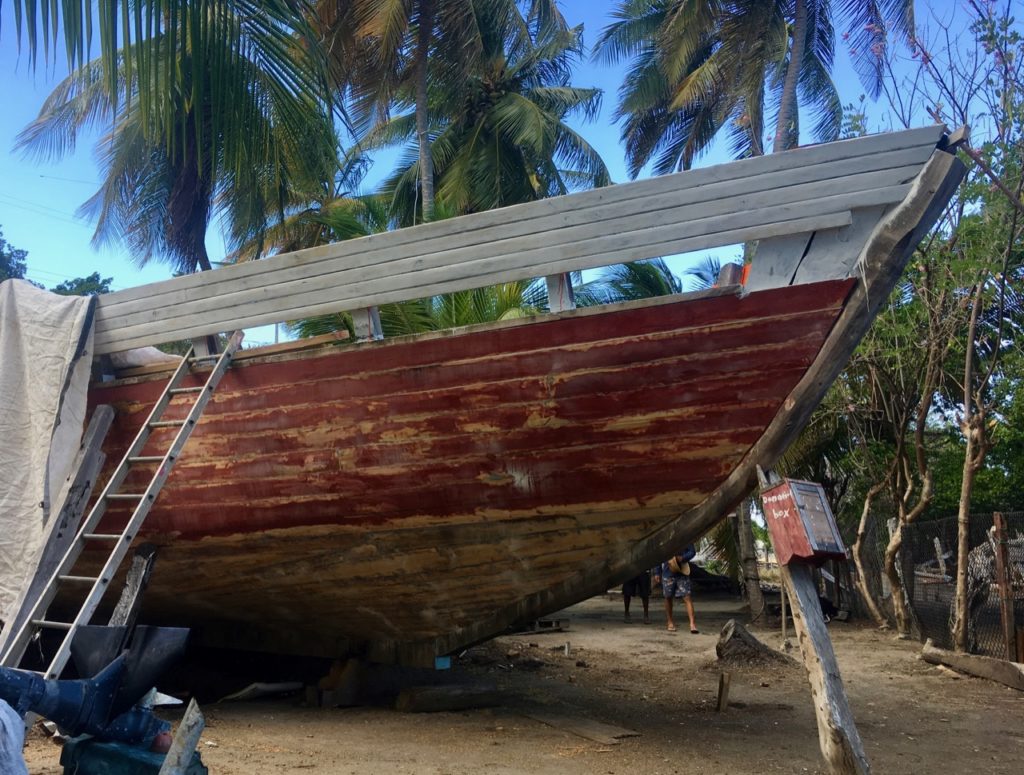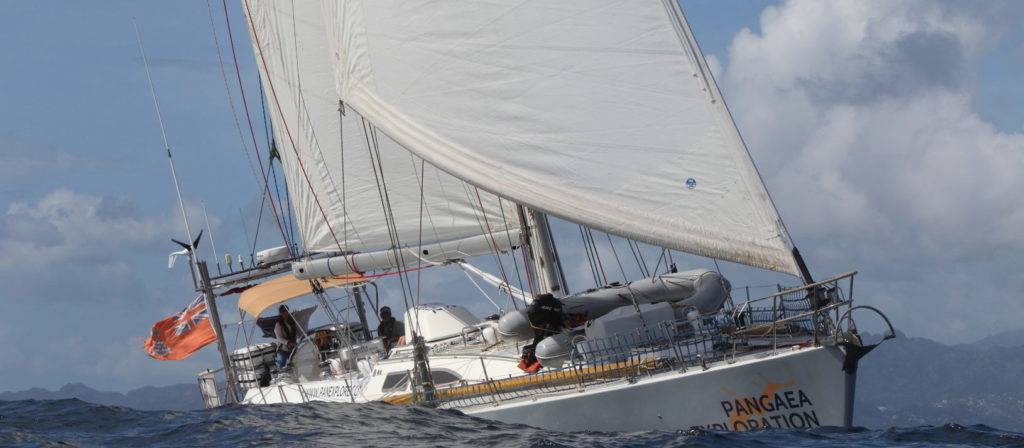As we get ready to return to Sea Dragon for her spring haul out, Shanley & I have thoroughly enjoyed sailing our own boat in the Caribbean. In a few weeks time we’ve covered countless islands and have had classic gorgeous trade wind sailing. One of the most fun things coming into a new bay and leaving another behind is seeing all the different boats along the way. From cruising cats, to traditional wooden boats, to strong well traveled hulls, we spend an awful lot of our time talking about boats. One common thread in all of this meandering is the importance of clearly defining what a boat will be used for, then designing it to that end. It really reinforces our respect for Sea Dragon’s performance, safety, comfort, and seakeeping when we take a look at all the other boats wandering the sea. We thought to share a few of the ones we’ve seen along the way, hoping to give you a taste of the many different stories in a small piece of this world.
About a week ago we stopped in Carriacou, the smaller of the two islands that make up the nation of Grenada, for a few nights. I first came to the Caribbean 10 years ago, and from that first visit until now, one constant highlight has been the occasional sighting of locally built, brightly painted wooden sloops. Some are yachts, some carry tourists, some are rotting on their moorings, but almost without fail they have come from Carriacou, which is the center of boat building in the Eastern Caribbean. I’ve been to Carriacou half a dozen times, but never until this visit have we managed to get over the hill to Windward, where these boats are built. After a loud bus-ride up and over the hills from Hillsborough we got off at the end of the line, near a sign saying simply “Boat Building Site.” We followed the arrow along the sargassum-strewn beach to a quiet palm-shaded yard where a surprisingly massive vessel was nearing completion, her bow pointed to the sea as it beckoned the water to lap upon her hull.

It was late afternoon, and Anthony McLawrence, the boat-builder, was cleaning up fallen branches and leaves from the yard in the shade of the trees. We chatted for a while, admiring his new build, and Anthony told us how when he was a child, this strip of beach would have up to a dozen boats being built at a time, some of them cargo schooners topping 80′ in length. Times have changed, and today there are only a few families with the skills to build these craft, and only Anthony has a boat being built right now. When we first walked through the gate we didn’t realize how large she was, but after getting a bit closer we realized that this wasn’t a small sloop or yacht – this thing was huge! The 65′ hull stretched back into the trees, and Anthony told us that he was not only the builder but the owner – this boat was going to carry cargo, sailing the islands of the lesser Antilles between the BVI and Trinidad. He and his crew been working on her for over two years now in his time off from his day job doing yacht repairs on the other side of the island, and is hoping to launch her this spring. Anthony pointed to a beamy, low-slung sloop sitting on a mooring just offshore with a towering rig and told us he had built her as a race boat for his brother, who regularly saw speeds over 10 knots while crushing his competition. Anthony’s cargo vessel, while built with different goals, shared her lines and inspiration with the race boat and should easily carry a load with a much less racy sail plan. Oh the different boats built on this one stretch of sand!

At a nearby boatyard on Carriacou, in Tyrell Bay, we happened across Iron Bark II, a slightly different take on traditional sailing craft but definitely purpose built. She’s a 31′ steel cutter with a full keel and gaff mainsail and topsail on an aluminum rig – a nice blend of traditional designs with modern materials. What really sets Iron Bark apart from other boats blocked around her is her voyaging career. Iron Bark belongs to Trevor Roberts, a determinedly little known Australian voyager who has spent his life at sea. This tough little cutter has spent at least two winters locked in the ice of the Antarctic peninsula and another in Greenland, and together with Trevor has racked up countless miles upon the world’s oceans. A whole fleet of similarly sized boats has been racing around the southern ocean this year in the Golden Globe race, racking up an impressive number of failures, sinkings, injuries, knockdowns, and withdrawals in the process. While racing certainly isn’t cruising, Iron Bark is resting peacefully in the yard after countless drama-free miles, while a fleet of repurposed fiberglass cruisers, not intended for anything like this kind of use, has been disintegrating across the Southern Ocean.

Here in Grenada is another example of just what can go wrong when a boat intended for one use unexpectedly finds another. This Catana charter catamaran was unceremoniously deposited on the rocks last weekend after, rumor has it, her mooring failed. With her speed, weight, and shallow draft, this was undoubtedly a wonderful boat for taking tourists on sailing holidays in the Caribbean, but Safari was never intended to spend five days being bounced on a rocky shoreline, and it’s sad to see her breaking up while salvage efforts get under way – this morning her port hull appears to be almost completely broken up. While no one willingly subjects their boat to this type of abuse, the pendulum of strength vs. weight is much more likely to swing one way for a vessel built for sailing alone in the arctic and another for one looking for sun and rum in the tropics.

These boats have been built for very different purposes: efficiently carrying cargo, unsupported solo voyages to the far ends of the earth, and luxurious sun-drenched holidays in pleasant anchorages. All of them fulfill their goals admirably, but when put into a situation that was never intended, like Safari, they may not be the best of options. One thing we really appreciate about Sea Dragon is that she was designed to safely carry a large amateur crew through the roughest oceans of the world. She certainly wouldn’t be great at cargo, and with our deep draft we can’t creep into shallow anchorages in chase of an idyllic patch of sand, and she is too big and powerful to be an easy boat to single-hand. However, she’ll make good time across oceans, keep her crew safely onboard while waves are sweeping across her decks, claw off a lee shore in 50 knots of wind, and provide comfortable, quiet bunks to keep her crew well rested through all of it. Sea Dragon is a wonderful platform, more than tough enough to handle anything that comes our way.






















